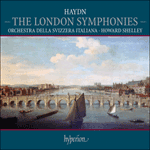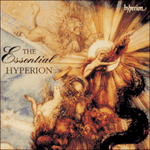
Welcome to Hyperion Records, a British classical label devoted to presenting high-quality recordings of music of all styles and from all periods from the twelfth century to the twenty-first.
Hyperion offers both CDs, and downloads in a number of formats. The site is also available in several languages.
Please use the dropdown buttons to set your preferred options, or use the checkbox to accept the defaults.

| Orchestra della Svizzera Italiana, Howard Shelley (conductor)» More |
In the eighteenth century G major was the pastoral key par excellence. And both the first movement and the minuet share the Andante’s bucolic associations. Typically, though, alfresco vigour is allied to a concentrated complexity of argument. In the first movement the floating repeated notes and rising chromatic lines of the slow introduction become vital ingredients in the bouncy 6/8 Vivace assai. This initially pretends it is in A minor rather than G major, an ambiguity that Haydn exploits throughout the movement, above all at the nonchalant start of the recapitulation. Only towards the end of the recapitulation, after what is in effect an intensive second development, is the fragile main theme allowed to reach a rounded conclusion. As the reviewer in the Morning Herald aptly remarked, ‘the subject … was remarkably simple, but extended to vast complication’.
The Allegro molto minuet is the fastest and lustiest in all Haydn’s symphonies, a rustic German dance complete with ‘oompah’ accompaniment—though, characteristically, the second part becomes more involved, with its irregular phrases, casual touches of counterpoint and recurrent three-note figure. The delicate trio features the favourite Haydnesque colouring of violins shadowed at the octave by bassoon. By now Haydn was renowned for the coruscating brilliance of his finales. But this one, a sonata-rondo launched by one of his catchiest tunes, arguably surpasses all his symphonic finales to date in its virtuoso handling of the orchestra, its harmonic drama and its comic brio. The timpani roll that batters the music into the alien key of E flat in the coda is a far more potent surprise than the Andante’s famous Paukenschlag, and the kind of coup de théâtre that left its mark on the young Beethoven.
from notes by Richard Wigmore © 2009
Au XVIIIe siècle, sol majeur était la tonalité pastorale par excellence; le premier mouvement et le menuet partagent les connexions bucoliques de l’Andante. Mais, une fois encore, la vigueur du grand air est amalgamée à une complexité concentrée de l’argument. Dans le premier mouvement, les notes répétées flottantes et les lignes chromatiques ascendantes de l’introduction lente deviennent des ingrédients vitaux de l’allant Vivace assai à 6/8, qui feint d’abord d’être en la mineur au lieu de sol majeur—une ambiguïté que Haydn exploite tout au long du mouvement, surtout au début nonchalant de la réexposition. C’est seulement vers la fin de cette dernière, après ce qui est en réalité un intensif second développement, que le fragile thème principal peut accéder à une conclusion harmonieuse. Comme le critique du Morning Herald le remarqua justement: «le sujet … était singulièrement simple, mais développé en une vaste complication».
L’Allegro molto est le plus rapide, le plus vigoureux de tous les menuets des symphonies haydniennes—une danse allemande campagnarde avec accompagnement en «oompah» (même si, comme d’habitude, la seconde partie se complexifie avec des phrases irrégulières, de sporadiques touches de contrepoint et une récurrente figure de trois notes). Le délicat trio arbore le coloris préféré du compositeur, avec des violons ombragés à l’octave par le basson. Jusqu’alors, Haydn était réputé pour ses finales étincelants, mais celui-ci, un rondo-sonate initié par un de ses airs les plus accrocheurs, recèle un traitement virtuose de l’orchestre, un drame harmonique et un trio comique surpassant, pourrait-on dire, tous ses finales symphoniques antérieurs. Dans la coda, le roulement de timbale qui défonce la musique dans la tonalité étrangère de mi bémol est bien plus surprenant que le fameux Paukenschlag de l’Andante—le type même de coups de théâtre qui marquèrent le jeune Beethoven.
extrait des notes rédigées par Richard Wigmore © 2009
Français: Hypérion
Im 18. Jahrhundert war G-Dur die pastorale Tonart par excellence. Und sowohl der erste Satz als auch das Menuett teilen sich die bukolischen Assoziationen des Andante. Typischerweise wird diese Freiluftenergie mit einer konzentrierten Komplexität der Verarbeitung verbunden. Im ersten Satz werden die schwebenden wiederholten Noten und aufsteigenden chromatischen Linien der langsamen Einleitung zu wesentlichen Bestandteilen im federnden 6/8-Vivace assai. Dies gibt zunächst vor, dass es in a-Moll statt in G-Dur steht, eine Zweideutigkeit, die Haydn den ganzen Satz hindurch ausbeutet, besonders im nonchalanten Anfang der Reprise. Erst gegen Ende der Reprise, nachdem effektiv eine intensive zweite Durchführung stattgefunden hat, wird dem zerbrechlichen Hauptthema erlaubt, einen abgerundeten Abschluss zu finden. Wie der Rezensent im Morning Herald treffend bemerkte, war „das Thema … bemerkenswert schlicht, wurde aber mit äußerter Komplexität ausgeweitet“.
Das Menuett, Allegro molto, ist das schnellste und rüstigste in allen Haydn-Symphonien, ein rustikaler Deutscher Tanz komplett mit „Humptata“-Begleitung—obwohl der zweite Abschnitt mit seinen unregelmäßigen Phrasen, hingeworfenen Anklängen an Kontrapunkt und seiner wiederkehrenden Dreinotenfigur charakteristischerweise involvierter ist. Das delikate Trio stellt Haydns beliebte Klangfärbung von Violinen, die in der Oktave vom Fagott begleitet werden, heraus. Haydn war inzwischen für die funkelnde Brillanz seiner Finals berühmt. Aber dieses Sonatenrondo, das von einer seiner eingänglichsten Melodien eingeleitet wird, übertrifft zweifellos all seine bisherigen Finales in der virtuosen Handhabung des Orchesters, seinem harmonischen Drama und komischen Trio. Der Paukenwirbel, der die Musik in der Coda in die fremde Tonart Es prügelt ist eine wesentlich schlagkräftigere Überraschung als der berühmte „Paukenschlag“ des Andantes und die Art Theatercoup, der den jungen Beethoven beeindruckte.
aus dem Begleittext von Richard Wigmore © 2009
Deutsch: Renate Wendel
 Haydn: The London Symphonies Haydn: The London SymphoniesIn 2009, the music world will commemorate the 200th anniversary of the death of Joseph Haydn. On Hyperion, Howard Shelley and his stylish Continental orchestra present the symphonies that made Haydn the most famous and popular composer alive in the 1 ...» More |
 The Essential Hyperion, Vol. 1 The Essential Hyperion, Vol. 1'You'll be discovering what a superb label Hyperion is' (The Modern Dance)» More |

